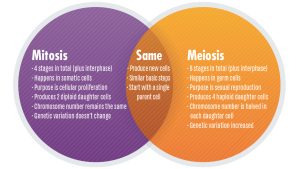
The ability to grow and reproduce is one of the most fundamental qualities of living organisms. Whether multicellular or unicellular organisms initiate their life from a single cell, i.e., zygote or fertilized egg. These organisms grow by the formation of new cells which the division of pre-existing cells produces. In short, cell division is the way growth and reproduction in an organism happens. Cells in eukaryotic organisms are produced from mitosis and meiosis so, knowing about the process of cell division is necessary. Also, to understand the concept it is crucial to know the difference between mitosis and meiosis. Also, we would answer some of the most asked questions such as the significance of cell division and more, stay to increase your knowledge.
What is Mitosis?
Mitosis is a procedure by which a parent cell divides into two similar daughter cells. These daughter cells are similar to each other and the parent cell as well. In mitosis, already distributed chromosomes are distributed into two daughter cells evenly so, each daughter cell gets an equal number of chromosomes as the parent cell. It was first observed by Strasburger in plant cells but the term was given by Walter Flemming in 1882. Mitosis mainly occurs in somatic cells of animals such as skin cells, fat cells, blood cells, etc. Because two daughter cells have the same number of chromosomes as their parent cell, it is also known as equational division.
What is Meiosis?
Meiosis also called reductional division is a type of double division in which a diploid parent cell forms four haploid cells. In meiosis, a single diploid parent cell forms four haploid daughter cells. It has two sequential cycles of nuclear division(karyokinesis) and one cycle of DNA replication which eventually results in four haploid daughter cells. It was studied by Strasburger and Benedin Winiwarter and the term was coined in 1905 by Farmer and Moore. The process of meiosis occurs in sex cells and some special cells. Meiosis is further divided into two: Meiosis I and Meiosis ll.
Difference between Mitosis and Meiosis
| S.no | Mitosis | Meiosis |
| 1. | The process of mitosis is also known as equational division since both daughter cells receive the same number of chromosomes as their parent cell. | Meiosis is also called reductional division as the parent cell(diploid) forms 4 daughter cells (Haploid). |
| 2. | Nuclear division (Karyokinesis) and DNA replication happen once. | Nuclear division happens twice but DNA replicates for one time. |
| 3. | The prophase of Mitosis is very short and has no sub-stages. | In Meiosis, Prophase l has 5 different sub-stages i.e., Leptotene, Zygotene, Pachytene, Diplotene, and Diakinesis |
| 4. | Here, no crossing over and chiasmata formation happens as there is no pairing of Homologous chromosomes. | Here, Homologous chromosomes pair utilizing synaptonemal complex and undergo crossing over during the pachytene stage, hence forming charismata. |
| 5. | In the metaphase of Mitosis, all chromosome forms a single plate. | Chromosomes form a single plate in metaphase ll and a dual plate in metaphase l. |
| 6. | At anaphase, the centromeres of chromosomes split, separating two chromatids of each chromosome. | Centromeres not split in anaphase l. In anaphase, ll centromeres split and chromatids separate. |
| 7. | Here, telophase occurs in all cases. | Here, telophase I am excluded sometimes. |
| 8. | It helps in growth, healing, and repair. | It maintains a constant number of chromosomes, and forms gametes or spores. |
Significance of Mitosis
Mitosis is a type of cell division and is significant for growth, repair, maintenance of cell size, and many more.
Mitosis is crucial for the growth and development of all multicellular organisms. Also, Somatic cells are formed from mitosis.
It maintains the size of a cell, if a cell becomes too large it undergoes mitosis to get its proper surface area to volume ratio.
Mitosis allows the healing of old wounds by producing new cells.
The main application of mitosis is maintaining the same number of chromosomes in the daughter cell as that of the parent cell.
In unicellular organisms, reproduction occurs through mitotic division.
Significance of Meiosis
Meiosis is responsible for the formation of gametes i.e., sperm and eggs for sexual reproduction. As it is known that gametes are important for reproduction because in organisms’ fertilization occurs through the fusion of two gametes. Meiosis is also called reductional division as it halves the chromosome number in gametes, such that fertilization restores the original diploid number of the Zygote.
It leads to variation among offspring which leads to better adaptability to the environment in the future.
Conclusion
Mitosis and meiosis are two very different processes yet, at the same time very essential and complementary to each other. Meiosis is needed for the continuity of species while Mitosis is crucial for the growth and development of cells. Also, both mitosis and meiosis are significant processes for cell division.
Frequently Asked Questions FAQs
1. Why do some cells divide by Mitotic division while others undergo meiosis?
The reason a cell undergoes Mitosis or Meiosis varies on the type of cell. Meiotic division occurs only in reproductive cells. Otherwise, the rest of the body’s cells divide through mitotic division.
2. What is the main distinction between mitosis and meiosis?
The most important difference is mitosis only cell division occurs and forms two daughter cells while in meiosis two consecutive cell divisions result in four haploid daughter cells.
3. What similarities do mitosis and meiosis have?
Apart from many differences, there are also some similarities between mitosis and meiosis. Some of them include:
Cell division occurs in both processes.
Both meiosis and mitosis occur in the cell nuclei.
Stages in both cycles are similar such as prophase, metaphase, anaphase, and telophase.
Synthesis of DNA happens in both mitosis and meiosis.
4. What are the functions of mitosis and meiotic division?
The main objective of mitosis is to produce springs that are similar to their parents with the same number of chromosomes on the other hand, meiosis is used for the production of gametes i.e., eggs and sperm.
5. What is direct cell division or Amitosis?
Amitosis is a mode of asexual reproduction that mainly occurs in acellular organisms such as bacteria, protozoa, old cells, diseased cells, and cartilage cells of mammals. It is also known as direct cell division.







